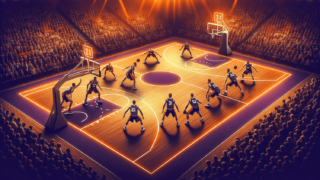
Are you tired of the same old defensive schemes? Interested in exploring a fresh and exciting concept that is making waves in the basketball world? If so, grab your favorite drink and make yourself comfortable, as we’re about to dive into the fascinating intricacies of the ‘Ice Defense’ in basketball. Our comprehensive breakdown will leave you inspired to take to the court and watch your opponents freeze under the pressure of this ingenious defensive tactic!
What’s an Ice Defense in Basketball?
An Ice Defense in basketball is a strategic defensive tactic that aims to stifle the opposing team’s pick-and-roll plays. It involves the on-ball defender forcing the ball handler away from the screen, while the off-ball defender, usually responsible for the screener, sags into the lane to prevent penetration. Essentially, this defense seeks to “ice” the pick-and-roll action, limiting the ball handler’s options and forcing less desirable shots from less optimal locations on the court.
Why Ice Defense Matters in Today’s Basketball Landscape
The modern game of basketball is heavily influenced by the pick-and-roll offense, an effective play designed to isolate a quick ball handler against a slower, less agile defender. To counter this play, teams are increasingly adopting the Ice Defense as a means of maintaining better control and dictating the opposing team’s offensive decision-making. Here we’ll dive into the significance of Ice Defense, featuring vital aspects such as positioning, communication, and adaptability.
Positioning: The Key to an Effective Ice Defense
Implementing an effective Ice Defense starts with proper positioning. A well-executed ice involves three primary defensive roles: the on-ball defender, the off-ball defender, and the help-side defender.
The On-Ball Defender: Guiding the Ball Handler
The on-ball defender’s primary goal is to prevent the ball handler from utilizing the screen, typically by positioning themselves between the ball handler and the screener. This forces the ball handler to move away from the middle of the court, diminishing the effectiveness of the pick-and-roll action.
The Off-Ball Defender: Depicting the Iceberg
Meanwhile, the off-ball defender (defending the screener) is responsible for dropping below the level of the screen, also known as “sinking” or “iendo.” By doing so, they establish a sort of iceberg-like barrier that curbs the ball handler’s ability to drive towards the basket. This positioning helps not only deny a clear path to the paint but also allows the off-ball defender to effectively recover to their original matchup when needed.
Help-side Defenders: The Unsung Heroes
Lastly, the help-side defenders play a crucial supporting role in an Ice Defense. Their primary job is to remain watchful for vulnerable gaps that may arise as a result of a successful pick-and-roll, and step in to impede any penetrative action by the offense. These are the defensive players that “seal the deal,” ensuring that the ice holds.
Communication: Rallying Your Basketball Crew
Proper communication between teammates is crucial for executing an effective and efficient Ice Defense in basketball. Timely and clear instructions from team members will enable the switch from one defensive strategy to another with minimal confusion and maximum impact.
Notify the On-Ball Defender
For starters, before the ball handler’s offensive play starts, the off-ball defender should notify their teammate about the screen. This allows the on-ball defender to anticipate the screen and make positional adjustments accordingly.
Make the Switch When Necessary
Effective communication between defenders also comes into play when switching assignments on defense. This often occurs when a team acknowledges that the ball handler has successfully navigated the screen or when circumstances necessitate a change in defensive roles. In such situations, a prompt alert can mean the difference between a successful defensive stand and a defensive breakdown.
Adaptability: Customizing Ice Defense for Your Team
No one-size-fits-all approach exists when it comes to Ice Defense. Teams must be prepared to adjust and adapt their strategies according to their specific needs, opponent tendencies, and game situations to reap the maximum benefits of this tactic.
Combating Elite Shooters
For instance, when facing an opponent with a skilled outside shooter, it’s imperative to limit their shooting opportunities. In such cases, the off-ball defender stalling in the paint might not be advisable — instead, they should instead be instructed to contest a potential three-point shot.
Putting the Brakes on Athletic Slashers
Alternatively, suppose the opposite team has an athletic slasher who excels at driving hard to the basket. In this scenario, the off-ball defender must be prepared to help early, and the help-side defenders must be ready to cover rolling threats from the paint or weak-side shooters.
Pick-and-Roll Countermeasures: Up Your Ice Defense Game
As we’ve covered the fundamental aspects of Ice Defense, it’s essential to explore some countermeasures when opposition teams get creative with their pick-and-roll strategies.
Utilizing Ball Denial
One possible countermeasure against a quick ball handler seeking to exploit pick-and-roll opportunities is to deny them the ball in the first place. By focusing on ball denial, defenders can force the offense to initiate the play from a less advantageous position or break the rhythm of the action.
Tagging the Roll Man
Another effective tactic that can be employed within the Ice Defense framework is “tagging the roll man,” where a help-side defender momentarily picks up the rolling screener. Such a move can interrupt the timing of the offensive action, providing the off-ball defender ample opportunity to recover and resume their original matchup.
Ice Defense: Significance for Youth and Amateur Basketball
While Ice Defense is readily employed at the highest echelons of professional basketball, its principles can also be extremely impactful in the context of youth or amateur leagues. Gaining proficiency in Ice Defense can provide a player or team an edge that significantly bolsters their overall defensive competency.
Sharing Basketball IQ
Implementing and practicing Ice Defense in amateur settings facilitates better understanding of defensive responsibilities, positioning, and spatial awareness. This not only improves a team’s proficiency in Ice Defense itself, but it also paves the way for effective communication and teamwork, essential components of a successful basketball team.
Confidence on the Defensive End
Acquiring and cultivating knowledge of advanced defensive strategies such as Ice Defense can instill a sense of confidence and preparedness in young players. When coaches introduce their aspiring athletes to these inventive tactics early on, they foster greater appreciation for the subtleties and nuances of the game, setting them up for future success in their basketball careers.
Summing It Up: Ice Defense as the Future of Basketball Defense
Ice Defense represents a forward-thinking approach to countering the pervasive pick-and-roll offenses prevalent in today’s basketball landscape. Understanding and implementing Ice Defense principles can lead to significant improvements in a basketball team’s overall defensive performance. By taking the time to learn and practice the tactical positioning, effective communication, and necessary adaptability that underscore this defensive philosophy, coaches, and players alike can take their game to the next level.
Developing Drills for Perfecting Your Ice DefenseAchieving successful implementation of the Ice Defense strategy on the basketball court requires diligent practice and the use of targeted drills. By incorporating various drills to hone players’ skill sets, any basketball team can systematically improve their application of this strategy.
Shell Drill
The Shell Drill is a widely used defensive practice in basketball, which can be easily customized for focusing specifically on Ice Defense tactics. Players are positioned at the four corners of the frontcourt, with the ball handler operating at the top of the key. Defenders are tasked with denying any opportunities for the ball handler to utilize the screen, while help-side defenders practice their responsibilities in the Ice framework. This drill grants coaches the opportunity to observe and critique each player’s position, communication, and rotation.
2-on-2 Ice Defense Drill
The 2-on-2 Ice Defense Drill focuses on perfecting the roles of the on-ball and off-ball defenders. It simulates pick-and-roll situations, enabling players to practice positioning themselves correctly to force the ball handler away from the screen. This drill also aids in identifying appropriate situations for switching assignments or doubling the ball handler.
3-on-3 Closeouts Drill
A 3-on-3 Closeouts Drill is designed to help players practice closing out on shooters, which is especially valuable when the on-ball defender is forced to move away from the perimeter due to the Ice Defense tactic. This drill emphasizes proper closeout techniques to deter quick passes or penetrate moves while also ensuring correct body positioning.
Analyzing Top Coaches and Their Ice Defense Strategies
To gain a deeper understanding of Ice Defense and its application in various game settings, it can be valuable to study the methods employed by successful coaches who utilize Ice Defense. These coaching visionaries are often adepts at tailoring this strategy to fit their team’s unique needs and characteristics.
Tom Thibodeau and the Chicago Bulls Era
As the head coach of the Chicago Bulls between 2010 and 2015, Tom Thibodeau orchestrated a highly effective Ice Defense system, which was instrumental in winning games and earning multiple playoff appearances. Under Thibodeau’s guidance, the Bulls showcased excellent defensive positioning and efficient switching, allowing them to successfully neutralize numerous pick-and-roll schemes. Delving into this hallmark era of Chicago Bulls’ coaching can provide valuable insights into strategic decisions and best practices associated with Ice Defense.
Studying the Minnesota Timberwolves’ Defense
Another noteworthy example of the efficient application of Ice Defense is that of the Minnesota Timberwolves. The team’s relentless pursuit of defensive perfection and expert game-management allowed them to foster an environment where the Ice Defense system could thrive. Studying game footage of the Timberwolves’ defensive play offers a great opportunity to grasp the intricacies of this strategy and discover new ways to improve your own team’s Ice Defense.
Beyond Ice Defense: Exploring Additional Defensive Strategies
While Ice Defense has proven to be an invaluable tactic for countering the pick-and-roll, no single strategy can guarantee universal success. As it’s vital for teams to be well-versed in numerous defensive strategies, exploring and mastering additional methodologies can provide a significant competitive advantage.
Hedging the Pick-and-Roll
Hedging refers to a defensive tactic whereby the off-ball defender momentarily steps out towards the ball handler to obstruct their path, ultimately forcing them to move laterally or backward. This temporary delay allows the on-ball defender to recover their position and resume their defensive assignment. By blending elements of hedging with Ice Defense, coaching staff can help ensure their team remains prepared for any offensive situation.
Switching on Screens
An alternative option to Ice Defense is for defenders to switch roles entirely when a screen occurs. This tactic can be employed in situations where the defenders are of similar stature and versatility, or when coaching staff anticipates potential mismatches that could be exploited by the offense. A combination of switching and Ice Defense can provide teams with the ability to adapt and outsmart the opposing team’s offensive strategies.
Zoning the Pick-and-Roll
Another complementary defensive approach is to use a zone-based scheme designed to combat pick-and-roll actions. For example, the 2-3 Zone Defense can be tailored to handle the pick-and-roll threat effectively by deploying specific rules for passing off responsibilities and providing help-side coverage. Merging elements from zone-based defenses with Ice Defense can create a highly flexible and adaptable defensive structure to handle a wide variety of offensive schemes.
Frequently Asked Questions about Ice Defense
If you’ve read our comprehensive blog post about the Ice Defense in basketball, you may have some additional questions or concerns. In this section, we’ll address ten of the most commonly asked questions regarding this defensive tactic, delving further into its intricacies and offering valuable insights for players and coaches alike.
1. How does the Ice Defense help teams control the pace of the game?
Ice Defense helps control the pace of the game by limiting the options available to the offense, particularly during pick-and-roll plays. This tactic neutralizes offensive momentum, disrupting the opposition’s preferred pace, and forcing them into less desirable and less efficient shooting zones.
2. How effective is Ice Defense against isolation plays?
While Ice Defense is primarily designed to counter pick-and-roll actions, it can also potentially be effective against isolation plays by emphasizing proper positioning and communication between defenders. The principles of excellent help defense and anticipation, both key components of Ice Defense, can contribute to hindering isolation plays as well.
3. Can Ice Defense be employed in combination with zone defenses?
Yes, Ice Defense can be employed in combination with certain zone defenses to create a hybrid system. This synergized defensive structure offers greater adaptability to various offensive strategies, including pick-and-roll plays, and ensures better court coverage and rebounding potential.
4. Is Ice Defense a man-to-man or zone defense?
Ice Defense is a specialized man-to-man defensive tactic with elements that can be incorporated into some zone defenses. Its primary purpose is to disrupt pick-and-roll plays, a common offensive threat present in modern basketball games.
5. How does the Ice Defense strategy differ from traditional switch defense?
Ice Defense differs from traditional switch defense in that it does not require defenders to switch assignments upon encountering a screen. Instead, the on-ball defender focuses on directing the ball handler away from the middle of the court, while the off-ball defender temporarily “sags” or “ices” the lane to prevent penetration.
6. What are some key countermeasures against teams that have mastered the Ice Defense?
Teams that have mastered the Ice Defense can be challenged through various countermeasures, including employing an off-ball screen, utilizing misdirection to exploit defensive rotations, driving by the sagging defender, or capitalizing on mismatches caused by defensive switches.
7. How do I determine the appropriate time to use Ice Defense during a game?
The appropriate time to use Ice Defense depends on factors such as opposing team tendencies, game situation, and available personnel. Analyzing the opposition’s pick-and-roll efficiency, as well as the matchups, can help coaches decide when to deploy this defensive tactic for maximum effectiveness.
8. Can teams inadvertently create mismatches when using Ice Defense?
Yes, if not executed correctly, Ice Defense can occasionally lead to mismatches, particularly when the on-ball defender is unable to recover their position in time, or when communication errors occur. Ensuring defensive rotations are well-timed and well-communicated is crucial for avoiding unnecessary mismatches.
9. What offensive strategies can exploit potential weaknesses in the Ice Defense?
Offensive strategies that can exploit the Ice Defense include using dribble hand-offs, quick ball reversals, or exploiting gaps in help-side defense by continuously swinging the ball to catch defenders out of position.
10. How does Ice Defense compare to other popular defensive tactics, like the Hedge or the Trap?
Ice Defense, Hedge, and Trap strategies each offer unique methods to counter pick-and-roll plays. The Ice Defense prioritizes directing the ball handler away from the screen and sagging in the paint, while Hedge involves the off-ball defender temporarily stepping out to slow down the ball handler. The Trap, on the other hand, aggressively doubles the ball handler near the screen to force a turnover or poor decision. Each of these tactics can be highly effective when used correctly, but the optimal choice will often depend on personnel, game situations, and opposing team tendencies.
Featured Posts
- No pillar pages found.





